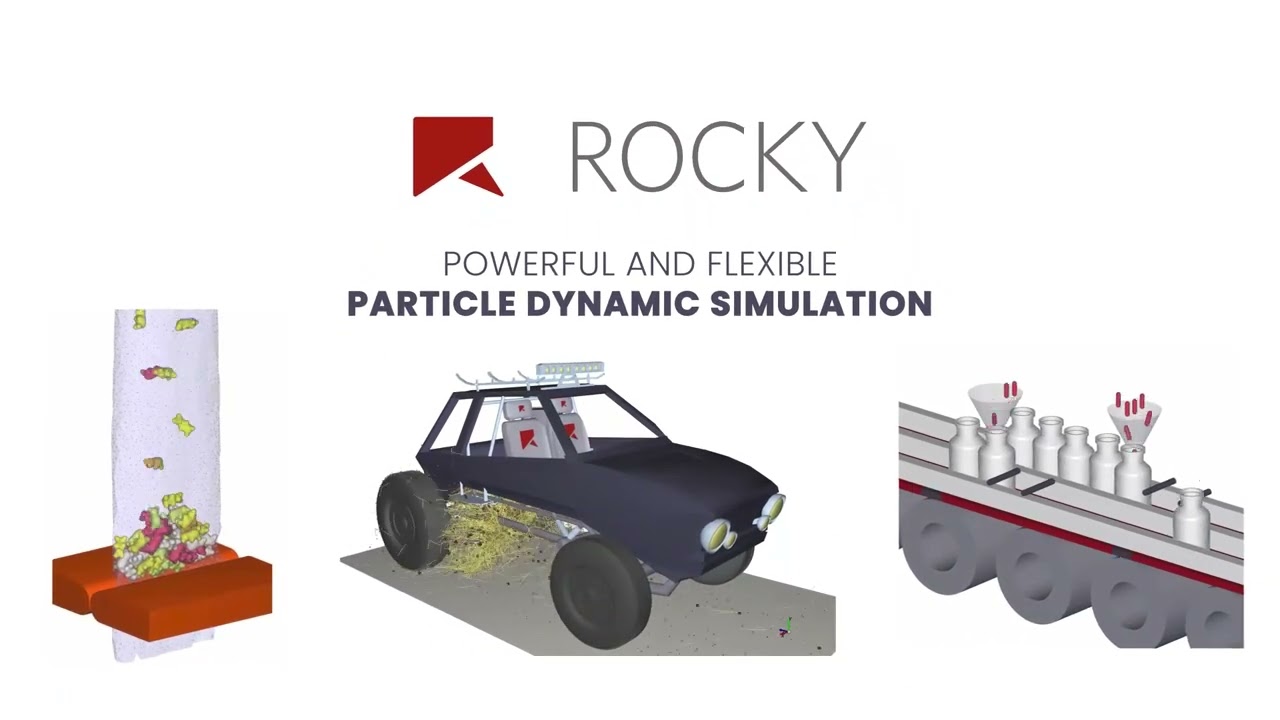
Introduction: Particle dynamics simulation plays a crucial role in various industries, including mining, pharmaceuticals, food processing, and manufacturing. Rocky DEM is a leading software solution for simulating the behavior of granular materials, powders, and bulk solids in industrial processes. In this comprehensive guide, we will explore the fundamentals, methodologies, and advanced techniques for simulating particle dynamics in Rocky DEM, covering everything from model setup to result analysis.
Section 1: Understanding Particle Dynamics Simulation
1.1 Overview of Particle Dynamics: Particle dynamics simulation involves modeling the behavior of individual particles or groups of particles in response to external forces, interactions with other particles, and environmental conditions. It is used to analyze processes such as particle flow, mixing, segregation, crushing, and impact in various engineering applications.
1.2 Importance of Particle Dynamics Simulation: Particle dynamics simulation enables engineers and researchers to study complex phenomena such as particle-particle interactions, particle-fluid interactions, and particle-wall interactions in granular materials. It provides insights into process optimization, equipment design, and product development, leading to improved efficiency, safety, and reliability in industrial processes.
1.3 Role of Rocky DEM in Particle Dynamics Simulation: Rocky DEM is a powerful software tool specifically designed for simulating particle dynamics in industrial processes. It uses Discrete Element Method (DEM) principles to model particle motion, collision, and interaction dynamics accurately, allowing engineers to analyze and optimize particle-based systems with precision.
Section 2: Modeling Particle Systems in Rocky DEM
2.1 Particle Properties and Characteristics: Engineers begin by defining the properties and characteristics of the particles being simulated, including size, shape, density, and material properties. Rocky DEM provides a library of predefined particle shapes and allows users to customize particle properties based on experimental data or theoretical models.
2.2 Boundary Conditions and Environment: Next, engineers specify boundary conditions and environmental parameters for the particle simulation, including container geometry, wall materials, gravity, fluid properties, and other external forces acting on the particles. Rocky DEM supports complex geometries, multi-body interactions, and coupled fluid-particle simulations to replicate real-world conditions accurately.
2.3 Particle-Particle Interactions: Engineers define interaction models to describe the behavior of particles during collisions, contacts, and interactions with neighboring particles. Rocky DEM offers various contact models, including linear spring-dashpot, Hertz-Mindlin, and Johnson-Kendall-Roberts (JKR), to simulate different types of particle-particle interactions and contact forces.
Section 3: Performing Particle Dynamics Simulation in Rocky DEM
3.1 Simulation Setup and Parameters: Engineers configure simulation settings, parameters, and control options within the Rocky DEM environment. They specify simulation duration, time steps, solver algorithms, and output settings to control simulation accuracy, stability, and performance.
3.2 Initialization and Run: Once the simulation setup is complete, engineers initialize the simulation and run the particle dynamics simulation in Rocky DEM. The software simulates particle motion, collision detection, contact resolution, and energy dissipation over time, generating detailed data on particle trajectories, velocities, forces, and interactions.
3.3 Post-Processing and Analysis: After the simulation run, engineers analyze and post-process the simulation results using Rocky DEM’s visualization and analysis tools. They visualize particle trajectories, track particle motion, calculate collision statistics, analyze energy transfer, and evaluate system performance metrics to gain insights into particle behavior and system dynamics.
Section 4: Advanced Techniques and Applications in Rocky DEM
4.1 Coupled Fluid-Particle Simulation: Rocky DEM allows engineers to simulate coupled fluid-particle interactions by coupling DEM with Computational Fluid Dynamics (CFD) simulations. This capability enables engineers to study phenomena such as particle suspension, sedimentation, fluidization, and particle-laden flows in complex fluid environments.
4.2 Particle-Wall Interactions: Engineers can model particle-wall interactions and boundary effects in Rocky DEM by defining wall properties, surface roughness, and contact parameters. This capability allows engineers to study phenomena such as abrasion, erosion, wear, and particle deposition on surfaces in industrial processes.
4.3 Multiphysics Simulation: Rocky DEM supports multiphysics simulation by integrating with other simulation tools and software packages, such as Finite Element Analysis (FEA) and Multibody Dynamics (MBD). Engineers can simulate coupled mechanical, thermal, and electromagnetic effects to analyze complex interactions and phenomena in particle-based systems.
Section 5: Best Practices and Tips
5.1 Model Validation and Verification: Validate and verify Rocky DEM models by comparing simulation results with experimental data, analytical solutions, or benchmark cases. Conduct sensitivity analyses, uncertainty assessments, and model validation tests to ensure that simulation results are accurate, reliable, and representative of real-world behavior.
5.2 Optimization and Design Exploration: Use Rocky DEM simulations for process optimization, equipment design, and product development by exploring design alternatives, analyzing performance trade-offs, and identifying optimization opportunities. Iterate on simulation models, parameters, and configurations to achieve desired objectives and improve system efficiency, safety, and reliability.
5.3 Continuous Learning and Professional Development: Stay updated on the latest developments, best practices, and advanced techniques in particle dynamics simulation and DEM technology. Participate in training programs, webinars, conferences, and user forums to enhance your proficiency in Rocky DEM, particle modeling techniques, and simulation methodologies.
Conclusion: Simulating particle dynamics in Rocky DEM offers engineers and researchers a powerful framework for analyzing and optimizing particle-based systems in various industries. By mastering the fundamentals, methodologies, and advanced techniques discussed in this guide, engineers can leverage Rocky DEM to study complex phenomena, optimize processes, and innovate in particle-based technologies. With its intuitive interface, robust simulation capabilities, and comprehensive analysis tools, Rocky DEM empowers engineers to tackle challenging particle dynamics simulation tasks and make informed decisions to improve system performance, efficiency, and reliability.